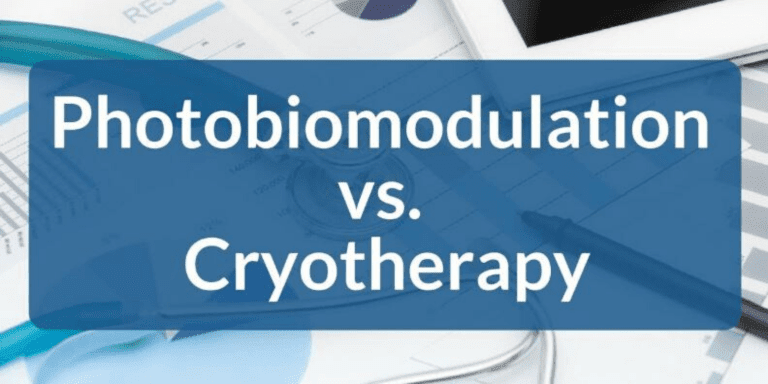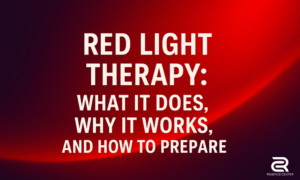When we started RegenUs Center, we had just gone through a major research process, for over one solid focused year and it was due to that research that we chose Photobiomodulation Therapy (Light or PBMT) over Cryotherapy, cold, as the foundation of our protocol.
Now I want you to keep in mind that we like Cryotherapy and will provide it in future locations of RegenUs Centers, but it’s a little further down the protocol than Photobiomodulation. Cryotherapy can be more effective when a regular protocol photobiomodulation comes first and depending on the condition of the client.
Cryotherapy, also known as “cryo” and cold therapy, is a treatment that relies on cold temperatures and freezing to produce a biological effect (Hormesis–what doesn’t kill you makes you stronger). Red light therapy devices deliver natural light to the body, rather than using heat or cold to induce a physiological reaction.
The reason why we went with photobiomodulation PBMT over cryotherapy, which is a lot more popular, as the foundation of our protocol is that photobiomodulation helps you “get better”, and cryotherapy helps you “feel better.” Which is not to say, PBMT does not make you feel better or that cryotherapy, doesn’t help you get better, it’s just that one is more fundamental than the other.
As a lifestyle coach, who specializes in human performance, I am always on the lookout for the hierarchy of therapeutic modalities, and the fundamentals, to reduce confusion when it comes to creating outcomes for my clients.
Simply put, light is more fundamental and essential to life than the cold, which is not to say that cold weather is not essential, it is, particularly for low biological stress it puts on the body, called hormesis. Hormesis is any process in a cell or organism that exhibits a biphasic response to exposure to increasing amounts of a substance or condition. Within the hormetic zone, there is a generally favorable biological response to low exposures to toxins and other stressors.
Light also has a hormetic effect, cryotherapy, has an even stronger one.
But when it comes to regeneration and recovery, photobiomodulation (changing the body with light) plays a more fundamental role than cryotherapy.
Here some interesting study content that was aggregated by Light Lounge.
Recovery & Regeneration SolutionsPerhaps you have heard of the recent trend in Recovery Solutions a spinoff from Regenerative Medicine. Many of these Recovery Solutions make claims that they will lower oxidative stress, improve recovery (measured as the ability to exercise longer and/or exercise with higher force output). One of these is Whole Body Cryotherapy (WBC), the technology that is used in cryosaunas, which briefly exposes the body to air temperatures below 100 ºC for 2- 3 minutes. Cryosaunas are becoming popular in fitness and wellness centers. Here we compare the technology and the evidence regarding WBC compared to Photobiomodulation Therapy (PBMT).
Recovery Solutions are important because high-intensity exercises are associated with the following: muscle injury, oxidative stress, inflammation, and fatigue. These all contribute to decreased performance.
Light Lounge is committed to evidence-based research on the side effects and efficacy of any intervention that claims performance and recovery enhancement.
Photobiomodulation & Cryotherapy
A randomly controlled, the single-blind study placed 40 participants into 5 groups:
1. Placebo Group
2. Photobiomodulation Therapy Group – PBMT applied to the biceps muscle belly
3. Cryotherapy Group (CG) – Ice bags applied to the biceps muscle belly
4. Cryotherapy/PBMT Group (CPG) – Cryotherapy first then PBMT
5. PBMT/Cryotherapy Group (PCG) – PBMT first then Cryotherapy
Participants performed Maximal Voluntary Contractions (MVCs). After a 2 min rest they performed 10 biceps curls with the highest strength possible to resist an isokinetic dynamometer (a machine that creates resistance at a constant speed). 30 seconds after the curls ended, another MVC was performed to measure how much the exercise had compromised the muscle. Additionally, each group performed an MVC 24, 48, and 72 hours after the exercise. Blood samples were also collected exactly 5 min, 60 min, 24 h, 48 h, and 72 h after the end of the exercise intervention.
There were no differences in the following measures before the exercise intervention between the groups:
- MVCs
- Oxidative damage to muscle and lipids
- Blood Creatine Kinase (CK) – a biomarker for muscle damage
- Delayed onset muscle soreness (DOMS) – this is thought to delay recovery
- TBARS – biomarkers for lipid damage
The results of the treatment groups vs. placebo group after the exercise intervention were as follow:
- The PBMT, PCG, CPG groups all had higher MVCs, lower lipid damage, and lower DOMS ratings 60 min, 24 h, 48 h, and 72 h after the exercise intervention
- The Photobiomodulation therapy group had decreased in CK across all post-intervention time points. The PCG and CPG were delayed at 48 h and 72 h
- The CG group demonstrated a decrease in lipid damage biomarkers, the only demonstrated difference between CG and placebo
The few benefits that cryotherapy had were heightened when PBMT was also applied. However, cryotherapy had no effect on MVC results compared to the placebo. The PBMT group had an increased MVC value. Cryotherapy had no protection against muscle damage (CK markers) whereas PBMT protected the muscle from damage better than any other treatment. In fact, applying cryotherapy in conjunction with Photobiomodulation therapy decreased the beneficial effects of PBMT (regardless of the order).
Not All Cryotherapies are the Same
The term Cryotherapy is used for both cold-water immersion, ice-pack application, and liquid nitrogen-based air cooling (whole-body chamber or partial body Cryosauna). A meta-analysis study examined 10 WBC controlled or crossover trials. In all the trials the authors found that due to the poor thermal conductivity of air, the muscle and body core cooling was not as effective as old fashioned techniques such as cold-water immersion and local ice-pack application. In a few studies they found that the participants receiving WBC had subjective improvements in muscle soreness and recovery, but this did not translate into increased performance. Additionally, the authors found no evidence to suggest that WBC helps to decrease muscle damage. There is little evidence to suggest that WBC can slightly decrease oxidative stress (as measured by lipid peroxidation). Counterproductively, however, WBC did lower anti-oxidant enzyme levels.
Additional data on the benefits and risks of Photobiomodulation Therapy vs Cryotherapy: Purpose, Differences, and Efficacy are provided by Aspen Laser.
There are benefits to both therapies when you look through the lens of benefits and risks (there are not risks for photobiomodulation) and in terms of a regeneration protocol and the applications for musculoskeletal muscle recovery, photobiomodulation therapy is superior to cryotherapy.
General Disclaimer: These services are not intended to diagnose, treat, cure or prevent any disease. This Website offers health and fitness advice. This advice is designed for educational purposes only and is not intended to replace the advice, treatment, or diagnosis of a healthcare professional. Always consult your physician before beginning any therapy program. You agree that you assume all responsibility when choosing to act on any of the health or fitness advice contained on this Website. We reserve the right to amend this policy at any time without any prior notice to you.





